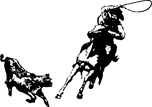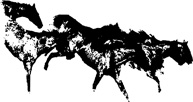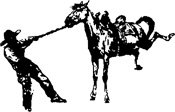Cowboy Wisdom (9 page)
Authors: Denis Boyles

I
f I’m going to get on a horse that someone else has saddled up, before I get on I’m going to check out the cinch and the blanket
beneath the saddle. If the blanket is not on right, it can rub the horse’s hair the wrong direction and give him saddle sores.
Then, you check the cinch. To do that, you make sure you can get two fingers between the strap and the horse’s belly. The
last thing I would look at is the bit—you want to be sure that it’s not too tight or too loose for the horse. Usually, I offer
to saddle up my horse for myself.
—S
HANA
Z
UCKER
Pinole, California 1993
W
hen your ass hurts more than your legs, that’s when you’ve got your stirrups adjusted to the right length. Some people say
you should stand beside the horse and your stirrups should end at the bottom of your armpit, but the bottom line is, you want
to be able to stand up in the stirrups a little bit—you want to be able to clear about two inches under your crotch when you
stand in them.
—B
RUCE
N
EGRE
Fresno, California 1994
I
t is the roper’s horse that can really make or break a champion. Keep your eye on that cow pony when the chute opens and the
calf breaks into a dead run in front of him. It’s the spectacular speed of the horse that gives the rider a chance to sling
that rope out and encircle the calf’s head—and it’s the action of the horse in keeping the rope taunt after the catch, that
helps the rider make “time.” Two throws are allowed before the rider is disqualified. The rider dismounts the instant the
catch is made, leaving the rope tied to the saddle horn. At this point, it’s the horse’s job to keep the rope just tight enough
by backing away or moving forward, always facing the calf until the tie is made. Three of the calf’s feet must be securely
tied with the piggin string. It’s “no time” for the cowboy if the calf can get up after it is tied.
—M
AX
K
EGLEY
Phoenix, Arizona 1942

S
ometimes it just happens where you’re standing over here, and your horse is over there, and there’s a whole heck of a lot
of big trouble in between. What you want in the worst way is to get to your horse, make a running mount, and clear out before
the bullets start to fly.
To do a running mount:
1. Run alongside your horse with both hands on the saddle horn. Then, as the horse picks up speed, but before he reaches a gallop,
you kick your feet forward to a point alongside about where his front feet are. Plant your heels. Then, what with the momentum
of the horse, you bounce up into the saddle, just like that.
2. Land in the saddle. As you jump, the horse’s about in the right position for you to swing your right leg over the saddle.
This does take a little arm strength, of course, but not all that much. It’s not as bad as doing a pull-up, even. But you
have to have enough strength to be able to keep yourself from going past the saddle and ending up on the far side of the horse.
3. Grab the reins before you put your feet in the stirrups. You ought to leave the reins around the horse’s neck, where you can
reach them easily. As you get better at this, you’ll do all three—land in the saddle, grab the reins, get your feet in the
stirrups—all at about the same time. But that’s the order, in case something goes wrong.
If you don’t get this right the first time, you’ll have a mighty powerful incentive to improve. You’ll only miss that saddle
three or four times before you get pretty accurate. I always find that experience is a swell teacher with something like this.
—R
OY
R
OGER

I
f ever there was a horse paradise, it was this staked plain of Texas, and here the mustangs were in all their glory—tens of
thousands of them. I have heard the number put as high as fifty thousand, and I believe that was a low estimate. These horses
were well grown, larger than the mustangs in south Texas, fourteen to fifteen hands high. Some of the stallions were over
fifteen hands and weighed 1,000 to 1,100 pounds.
—F
RANK
C
OLLINSON
El Paso, Texas c. 1936
T
he wild horse can see, hear, and smell a man farther than any other animal, except a woman.
—F
RANK
M. L
OCKARD
Norton, Kansas 1924

|
W
hen chasing mustangs| the rider had better not be riding a plug draft horse if he expects to keep within the dust. The rider
should change horses as often as possible and riders should be relieved as often as convenient. After four or five days of
about seventy-five miles per day, the horses become tired and will let the rider come within two hundred yards of them.
The first horse caught should be the stallion with the largest harem. Then his harem should all be caught and put with him,
when all the herd have been clogged, except the yearlings and two-year-olds, and some of the weaker ones. The herd is brought
to within fifty yards of the tent door at sunrise and kept there until noon. Then the man in charge will whistle to them and
start them toward the lake to drink and graze for one hour and a half. He then brings them back to the same place to stand
until sundown, when they are started to the lake to spend the night. This procedure is repeated every day, the reason being
that if the horses graze all day, they will wander away at night. But if they are kept hungry all day, they will graze at
night and not be far away in the morning.
—H
OMER
H
OYT
Greeley, Colorado 1934
N
othing scares a horse quicker than a quiet thing that moves toward him and makes no noise. He will jump and break his neck
at a noisy movement of a rodent in the grass or a falling twig, while a roaring buffalo or a steaming train will pass him
unnoticed. That is because he has the same kind of courage that man has: Real courage, the courage to face any odds that he
can see and hear and cope with, but a superstitious fear of anything ghostlike.
—C
HIEF
B
UFFALO
C
HILD
L
ONG
L
ANCE
Cardston, Alberta, Canada 1928

T
he first act in breaking a horse is to catch him. In the early days this was done by penning the
manada
, the bunch of mares, with which the young, unbroken horses ran, then roping the
potro
—the unbroken horse—that had been selected. If there were a choice, the selection would be of a
potro
about five years old. Any horse younger than this lacked the strength and endurance to do the hard work that might be required
of him; older than this, the horse would be harder to break.
—R
UTH
D
ODSON
Mathis, Texas c. 1940

W
hen you go to ride a bad horse, first get your horse by the bridle and pull his head to one side as far as you can and stick
your five fingers in his eyes as deep as you can and if the horse pitches, sit as limber as you can and twist your toes around
in your saddle stirrup and you will find that it will be much easier on you and always handle stubborn horses rough and use
limber bits and make him go your way and not his.
—L
ONDON
B
ROWN
Nocona, Texas 1892

M
y granddad taught me how to fall from a horse: When you hit the ground, you curl. He said, “There will come a time when you’re
going to get bucked, and you’re going to need to know what to do so you don’t get stepped on.” And you do that by curling
in; you get your arms and legs in real close to your body—unless you feel like waving ’em around out there in front of the
horse like a target.
—V
ALERIE
F
ARMER
Shreveport, Louisiana 1994
T
here are more horses’ asses in the world than there are horses.
—G
AGE
L
OVETT
M
ARTIN
1964
